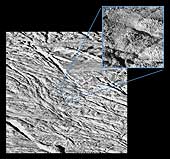|
COMETS EARTH JUPITER KUIPER BELT MARS MERCURY METEORITES NEPTUNE OORT CLOUD PLUTO SATURN SOLAR SYSTEM SPACE SUN URANUS VENUS ORDER PRINTS
PHOTO CATEGORIES SCIENCEVIEWS AMERICAN INDIAN AMPHIBIANS BIRDS BUGS FINE ART FOSSILS THE ISLANDS HISTORICAL PHOTOS MAMMALS OTHER PARKS PLANTS RELIGIOUS REPTILES SCIENCEVIEWS PRINTS
|
Related Documents
Download Options
The tortured southern polar terrain of Saturn's moon Enceladus appears strewn with great boulders of ice in these two fantastic views -- the highest resolution images obtained so far by Cassini of any world. This comparison view consists of a wide-angle camera image (left) for context, and a high-resolution narrow-angle camera image (right). The two images were acquired at an altitude of approximately 208 kilometers (129 miles), as Cassini made its closest approach yet to Enceladus. The wide-angle view shows what appears to be a geologically youthful, tectonically fractured terrain. In the narrow-angle view, some smearing of the image due to spacecraft motion is apparent. Both of these views were acquired as Enceladus raced past Cassini's field of view near the time of closest approach. At the time, the imaging cameras were pointed close to the moon's limb (edge), rather than directly below the spacecraft. This allowed for less 'motion blur' than would have been apparent had the cameras pointed straight down. Thus, the terrain imaged here was actually at a distance of 319 kilometers (198 miles) from Cassini. At the fine scale afforded by the Cassini spacecraft narrow-angle view, the surface is dominated by ice blocks between 10 and 100 meters (33 and 330 feet) across. The origin of these icy boulders is enigmatic. Scientists are interested in studying the sizes and numbers of the blocks in this bizarre scene, and in understanding whether terrain covered with boulders is common on Enceladus. The images in this comparison view are available individually (see PIA06251 and PIA06252). Image scale is about 4 meters (13 feet) per pixel in the narrow-angle image and about 37 meters (121 feet) per pixel in the wide-angle image. The wide-angle image has been magnified by a factor of two. The contrast in both images has been enhanced to improve the visibility of surface features. |
